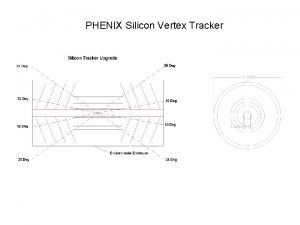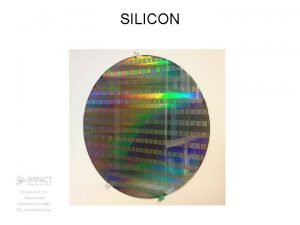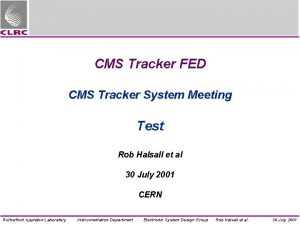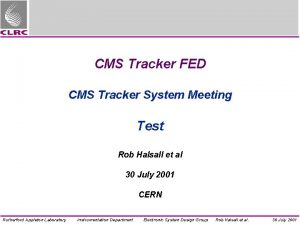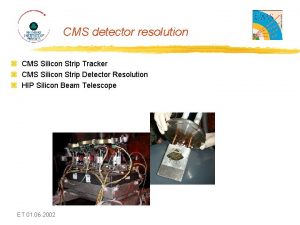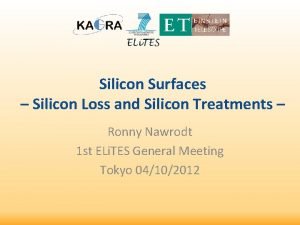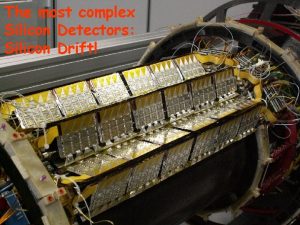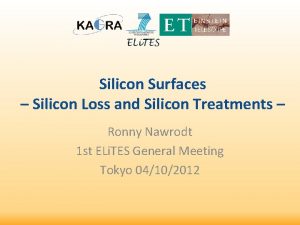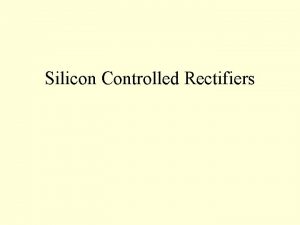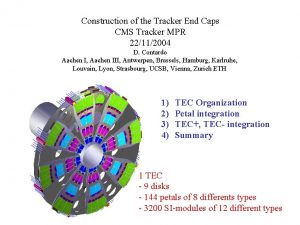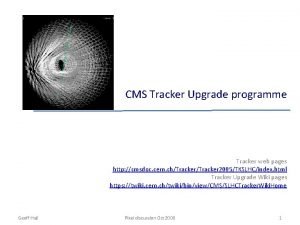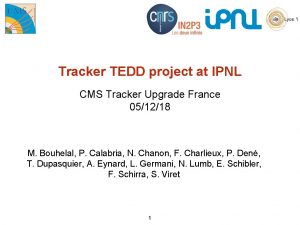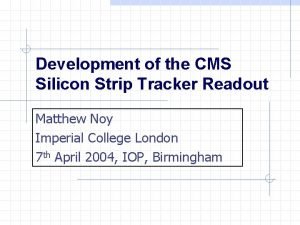Design process of the CMS Silicon Tracker for



![Upgrade scenario Phase I upgrade – around 2014 [Lpeak ≈ 2*1034 cm-2 s-1] lower Upgrade scenario Phase I upgrade – around 2014 [Lpeak ≈ 2*1034 cm-2 s-1] lower](https://slidetodoc.com/presentation_image_h2/fea0dc385187cee7e62bd9c73b637a8c/image-4.jpg)

![Pixel - Phase I [mm] R-Phi view R-Z view (rec-hit ‘radiography’) Geometry implemented in Pixel - Phase I [mm] R-Phi view R-Z view (rec-hit ‘radiography’) Geometry implemented in](https://slidetodoc.com/presentation_image_h2/fea0dc385187cee7e62bd9c73b637a8c/image-6.jpg)








- Slides: 14

Design process of the CMS Silicon Tracker for Super-LHC C. Civinini INFN, sezione di Firenze, Italy On behalf of the CMS Collaboration EPS-HEP 2009 Kraków. Poland July 16 th-22 nd 2009

LHC Upgrade The CMS detector has been designed to operate for 10 years (~300 fb-1) at a luminosity of 1034 cm-2 s-1 A possible upgrade of the collider will increase the maximum instantaneous luminosity up to 1035 cm-2 s-1 to collect data samples of the order of a (few) ab-1 A large part of the CMS detector can cope with this scenario with some modifications The silicon tracker will definitely not survive and need to be replaced (in two different phases) 18/07/2009 C. Civinini - INFN Firenze EPS-HEP 2009 Kraków 2

A new tracker The present performance, in terms of tracking and vertexing, should be maintained in a much more demanding environment More granularity for similar occupancy at higher luminosity Introduce L 1 track trigger capability The crucial point is to reduce as much as possible the material budget e, g conversion, hadronic interactions Mass driven by power + cooling Constraint: reuse external services Pipes, cables, fibres Powering scheme based on DC-DC converters 18/07/2009 C. Civinini - INFN Firenze EPS-HEP 2009 Kraków 3
![Upgrade scenario Phase I upgrade around 2014 Lpeak 21034 cm2 s1 lower Upgrade scenario Phase I upgrade – around 2014 [Lpeak ≈ 2*1034 cm-2 s-1] lower](https://slidetodoc.com/presentation_image_h2/fea0dc385187cee7e62bd9c73b637a8c/image-4.jpg)
Upgrade scenario Phase I upgrade – around 2014 [Lpeak ≈ 2*1034 cm-2 s-1] lower mass new pixel system with 4 barrel layers & 3 endcap disks CMS design for easy pixel replacement means system can be exchanged in any normal winter shutdown The rest of the tracker will be left untouched Phase II upgrade – after 2018 - requires complete tracker replacement [Lpeak ≈ 1035 cm-2 s-1] enhanced pixel system with Phase I layout study PT (stacked) layers to contribute to trigger (and alternatives) design outer tracker to match cost, power and performance needs 18/07/2009 C. Civinini - INFN Firenze EPS-HEP 2009 Kraków 4

Pixel – Phase I New pixel system (4 barrel layers + 3 disks per side) 1. 2. 3. 4. Factor x 1. 6 on the number of channels More layers/disks for robust patter recognition and track seeding Reduction of material in tracking region Higher rate capability, reduce readout dead time Evaporative CO 2 cooling Front-end chip (PSI 46 ROC) upgraded 160 MHz digital readout + deeper buffer Barrel modules with 1. 2 m long pigtails Shift part of material away from central region Use the same external services Minimal impact on data taking 18/07/2009 C. Civinini - INFN Firenze EPS-HEP 2009 Kraków 5
![Pixel Phase I mm RPhi view RZ view rechit radiography Geometry implemented in Pixel - Phase I [mm] R-Phi view R-Z view (rec-hit ‘radiography’) Geometry implemented in](https://slidetodoc.com/presentation_image_h2/fea0dc385187cee7e62bd9c73b637a8c/image-6.jpg)
Pixel - Phase I [mm] R-Phi view R-Z view (rec-hit ‘radiography’) Geometry implemented in CMS simulation and reconstruction program [mm] Total barrel weight: 1267 g a factor 3. 1 down with respect to the present detector 18/07/2009 C. Civinini - INFN Firenze EPS-HEP 2009 Kraków A. Tricomi 6

Pixel – Phase I Using triplets as track seed (3 hits in 4 pixel layers) reduce combinatorial and fake rate keeping the reconstruction efficiency unchanged m+ m- back-to-back Pt = 100 Ge. V/c + pileup Mean # of seeds/ev = 2100 Mean # of reconstructed tracks/ev = 505 Seeding efficiency vs h L=2*1034 cm-2 s-1 h 18/07/2009 C. Civinini - INFN Firenze A. Tricomi EPS-HEP 2009 Kraków 7

Phase II – Level 1 Track Trigger At 1035 cm-2 s-1 the single e and m trigger rate will easily exceed 100 k. Hz Increasing pt thresholds (and using isolation from calorimeters) will not help too much Tracker information helps to improve trigger discrimination power L = 1034 cm-2 s-1 muon L 1 trigger rate CMS – DAQ and HLT TDR – CERN/LHCC 02 -26 18/07/2009 C. Civinini - INFN Firenze EPS-HEP 2009 Kraków 8

Phase II Track Trigger principles Impossible to transfer all data off-detector for decision logic so on-detector data reduction (or selective readout) essential Aim not to degrade tracking performance – but trigger layers will need extra power (material) compared to normal layers What are track-trigger requirements? (under study) electron – Present HLT uses inner tracker point to validate projection from the calorimeter muon - a tracker point in a limited -f window to resolve ambiguous muon candidates and improve p. T jets – information on proximity/local density of high p. T hits ? separation of primary vertices - ie: 300 -400 vertices in ~25 cm 18/07/2009 C. Civinini - INFN Firenze EPS-HEP 2009 Kraków 9

Phase II- Track Trigger methods Transfer only hits generated by high pt particles If able to discriminate pt> O(1) Ge. V/c a rejection factor of ~ 20 can be obtained Two methods: High multiplicity 1. Cluster width cluster Pass Select hits with low strip multiplicity 2. Stacked layers ~1 mm Correlate hit positions in closely spaced (~mm) layers ~100μm 18/07/2009 C. Civinini - INFN Firenze Fail Upper Sensor Lower Sensor G. Parrini EPS-HEP 2009 Kraków 10

Stacked layers At fixed detector pitch sensor separation determine the effective pt cut • Increasing separation pt selection broader transition region Reduced high pt efficiency (more combinatorial) R=25 cm higher Performance of a stacked layer at R = 25 cm 10, 000 di-muon events with smearing 18/07/2009 C. Civinini - INFN Firenze e. g. , 2 mm separation rejects almost 100% below pt=3 Ge. V/c M. Pesaresi EPS-HEP 2009 Kraków 11

Phase II – Layout simulations 1. Two (or more) PT layers cover full h range R = 25 – 35 cm plus Outer tracker R-z view endcaps or long barrels? short sensors ~ few cm 2. “All trigger” 3 D long barrel layers constructed as doublets pixels ~1 mm x 100µm Both will incorporate an upgraded Phase-I pixel system as starting point (not shown) R-z view http: //abbaneo. web. cern. ch/abbaneo/tkgeometry/summaries/ 18/07/2009 C. Civinini - INFN Firenze EPS-HEP 2009 Kraków 12

Conclusions To follow the expected increase in luminosity of the LHC, the CMS silicon tracker will undergo two major hardware upgrades: Phase I: new pixel system capable to measure four points per track with a factor 3 less material Phase II: a totally new tracker, incorporating: L 1 track trigger enhanced pixel system with Phase I-like layout mini-strip based external and endcap tracker Performance similar to the present tracker Big issues: cooling and power material budget Sensor technology 18/07/2009 C. Civinini - INFN Firenze EPS-HEP 2009 Kraków 13

Thanks to many CMS Tracker collaborators, past and present, too numerous to acknowledge individually 18/07/2009 C. Civinini - INFN Firenze EPS-HEP 2009 Kraków 14
 Cms database design
Cms database design Kontinuitetshantering
Kontinuitetshantering Typiska drag för en novell
Typiska drag för en novell Tack för att ni lyssnade bild
Tack för att ni lyssnade bild Vad står k.r.å.k.a.n för
Vad står k.r.å.k.a.n för Shingelfrisyren
Shingelfrisyren En lathund för arbete med kontinuitetshantering
En lathund för arbete med kontinuitetshantering Särskild löneskatt för pensionskostnader
Särskild löneskatt för pensionskostnader Tidbok yrkesförare
Tidbok yrkesförare Anatomi organ reproduksi
Anatomi organ reproduksi Vad är densitet
Vad är densitet Datorkunskap för nybörjare
Datorkunskap för nybörjare Stig kerman
Stig kerman Debattinlägg mall
Debattinlägg mall Delegerande ledarskap
Delegerande ledarskap















